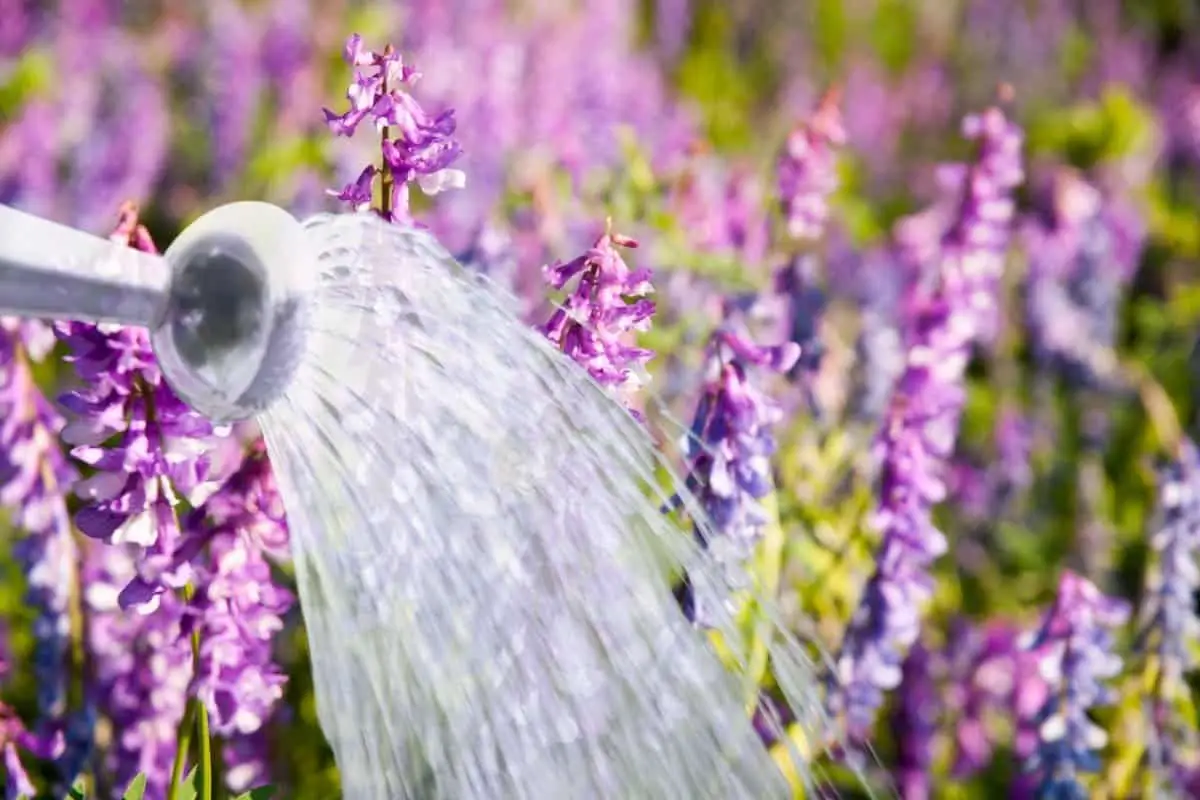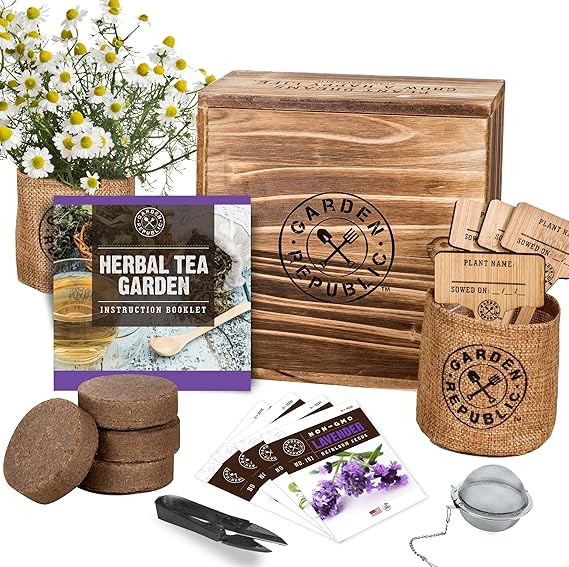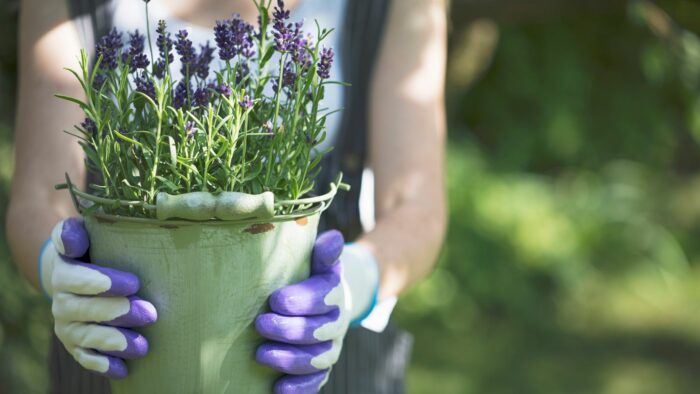Last Updated on April 6, 2023 by Griselda M.
It is important to understand how much water does lavender need, especially if you aim to keep your plant healthy and happy. Have you ever wondered how often to water lavender because of how fast it dies from under or overwatering?
Lavender is popular in the countryside of Southern France where it is grown for the perfume industry. In North America, it is a shrubby perennial grown for its flowers and fragrance. It also serves as a beautiful flower for the landscape.
Lavender is a formal garden plant that may be clipped to form a low hedge or an aromatic border along a path. In a rock garden, lavender plants are a great effect that beautifully accents the area. It is also a natural choice for any herb garden.
The cool grey-green foliage contrasts nicely with its own flowers as well as the dark green herbs and other plants. It does well in containers just as it thrives in the garden. This plant is considered an annual in the South but also thrives in arid western climates.
When Does Lavander Bloom?
Lavender offers many varieties and has a vast selection of bloom times, flower forms, colors, and sizes. Bloom time varies between one location and another – where one bloom at the start of June and another at the end of the same month.
Contrary to what many people know, not all lavenders are purple. Some hybrids come in other lovely pastel hues like yellow, pale pink, rose, or violet-blue. The leaves also vary in shape and color, and you can extend the bloom season as well as a color palette by planting different varieties together.
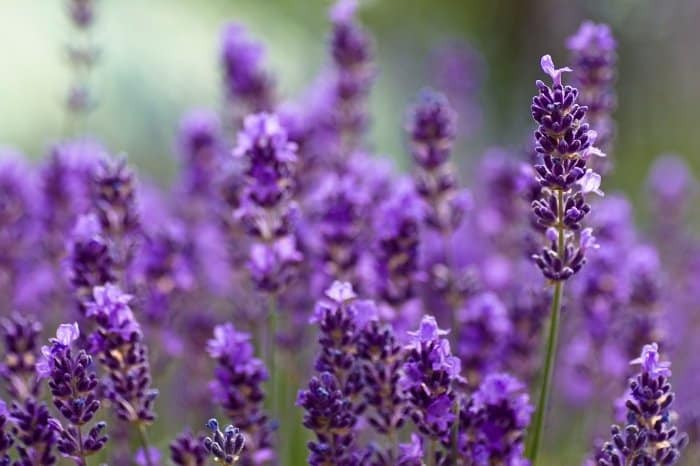
How Much Water Does Lavender Need?
Lavender requires a good amount of water to promote root growth. But if you underdo or overdo it, you will end up with dead plants. If you have lavender planted on a large scale, it is advisable to irrigate twice a year, which is enough. Short and frequent watering cycles result in unhealthy roots that could rot.
Planting and Pruning Lavender
All lavender varieties require well-drained soils, especially during the winter months. To ensure you have good draining soil, mix some sand or gravel into the soil before you plant lavender, or grow the plants in mounds, slopes, or raised beds. Instead of applying moisture-holding mulches, consider using stone or rock, especially in hot and humid climates.
Always check your soil pH to make sure it’s not too acidic because it will kill your plants. You can amend your soil with lime to better accommodate your lavender plants.
Indoor Herb Garden Seed Starter Kit – Herbal Tea Growing Kits,
Once the lavender becomes established, it will require minimum watering and pruning. Prune your stems when they grow and become woody. Prune it back to about half its height in the spring to promote fresh growth and robust flowering in the summer. If you do not prune your plants, they will sprawl, leaving a hole in the middle. Clip faded blooms during summer to encourage repeat blooming throughout the season.
Lavender Varieties
Lavender is commonly grouped into 4 classes and has a vast array of hybrids that have been cultivated for specific growing conditions and climates all around the world. The 4 classes include:
- Lavandula multifida – This is the Egyptian hybrid a.k.a. fern leaf lavender
- Lavandula angustifolia – It is the English hybrid a.k.a. true lavender
- Lavandula stoechas – This is the original French hybrids
- Lavandula dentata – It is a well-known Spanish hybrids
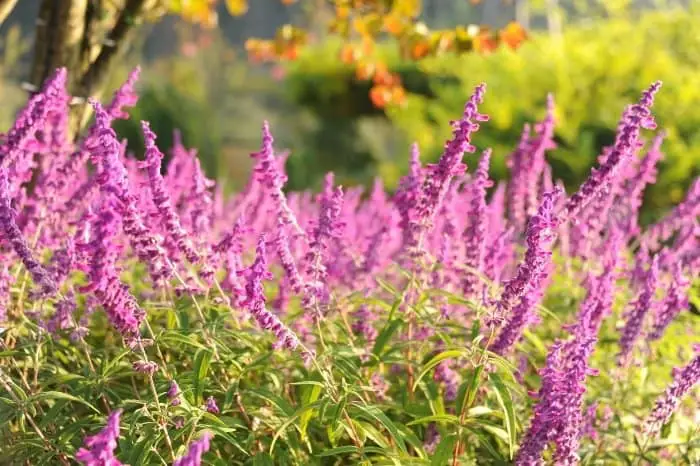
Lavender Growing Conditions Indoors Plus the Amount of Water Needed
If you choose to grow lavender indoors in pots or are bringing them inside to protect them from frost, it is possible, but the plant will need a good amount of care. The care tips include:
- Choose a variety that does well indoors, like the Lavandula dentate. This variety has smaller plants that do well in pots.
- Place your plant near a southern-facing window and consider providing supplemental lighting using grow lights if it is placed in a dark room.
- If you move your plants indoors due to the cold weather, expect them to slow their growth process; but it is better than allowing them to die outside.
- Don’t overwater your potted plants – remember, lavender hates water. Use pots that are close in size to the root ball of your plant. Any larger pot prompts you to overwater, which ends up waterlogging your plant.
- Add a layer of gravel to the base of the pot to assist with drainage, and use a terra cotta pot – this helps in releasing moisture and preventing rot.
- Check your soil for acidity and add lime every month if need be.
How Often to Water Lavender in Pots?
If you’re wondering how often to water lavender in pots, then let me enlighten you. Lavender is a plant that does not have a high demand for moisture, so feeding it the correct amount of water once every two weeks should be ideal. However, seeing that potted plants tend to dry out faster, it is advisable to pay closer attention to it when it comes to watering schedules.
Therefore, feeding your potted lavender with water even after it rains, is recommended. Keep in mind that over or underwatering your lavender in pots can prove detrimental to the health and development of your plant. This is because an overwatered lavender plant can produce yellowing lower leaves, may droop, and emit a rotting odor. These are indicators that your plant is deteriorating due to sodden waterlogged soil.
For this reason, it is essential that you first check the soil before watering. Also, ensure that the water drains completely through the drainage holes when watering lavender in pots. Empty the bottom tray immediately thereafter to avoid problems. Although lavender is a bit drought tolerant once established, growth and flowering enhancements are acquired through timeous watering schedules according to the plant’s demands.
How Often to Water Lavender in Summer?
So, how often does water lavender in summer? It is advisable to water your lavender plants according to their demand until they become established. Thereafter, watering lavender once a week or more in the summertime is advised. However, if you have lavender in pots, then during the hot season, these plants grow best when they are watered on alternate days.
Keep in mind that you should avoid wetting the lavender foliage when watering. Following a proper watering schedule for lavender plants will also enhance flowering. These plants usually bloom in June and July. The flowers last around three or four weeks if the plant is offered the right care. It is also essential to test the soil for dryness to determine when to water lavender.
If it appears that the top two inches of the soil are dry, then that is an indication of water. We understand that while some areas experience harsh summer months, others have milder ones. Therefore, testing the soil for the moisture is recommended as it will give you a better idea of whether water is needed or not. However, if you do forget to water your lavender for a day or two, there is no need to fret because these plants are a little rough and hardy.
How Often Does Lavender Bloom?
If you are wondering how often lavender blooms, then take heed of the following information. Lavender produces flowers from the start of the spring season to the mid-summer. Thereafter, you will find that these plants have a resting period that doesn’t last very long. This is because they actually reproduce in the late summer once again.
If lavender is planted in an area that experiences mild summers and winters, then blooming can be witnessed much earlier. In this case, these plants can produce blooms three or four times a year. In other words, you can enjoy the aromatic fragrance of lavender blooms from spring till summer, and in some cases where the weather permits, even beyond that.
Additionally, you also have the choice of opting for different varieties of lavender plants that flower continuously. Keep in mind that to enjoy abundant blooms, the environment, climate, watering schedules, care, and maintenance play a vital part in the process. Correct siting and judicious pruning will keep your lavenders around for five to seven years, if not more.
Does Lavender Need Full Sun?
So, you want to know, does lavender need full sun? The answer is yes, these plants do have their demands to grow their best, and full sunlight exposure is one of them. In regions with extremely hot summer climates, lavender plants appreciate some afternoon shade. Aside from light exposure, it is vital to never forget how much water does lavender need to grow its best.
You must remember that these plants have a low demand for water as they are slightly drought-tolerant. Together with moderately fertile soil and moisture, and full sun exposure, you can bask in fields of lavender and enjoy their fragrant blooms. However, if you find that your lavender in pots or the ground is wilting, yellowing, or drying, then this is a cause for concern.
I say this because just like every living thing, too much of anything can prove damaging. Therefore, the above-mentioned flaws should not be ignored if they are present in your lavender plant. This is because this type of deterioration is usually caused by excessive sun exposure that is stressing your plant.
In this case, you should trim off any damaged foliage and ensure that your potted lavender plant is not left out in the harsh rays of the sun for extended periods. If you live in a region that has less sun, then you should consider growing French lavender, French lace lavender, or Spanish lavender which is slightly more shade tolerant.
Lavender Watering – Conclusion
It’s your turn to grow your own lavender! Lavender is beautiful and low-maintenance. It is easy to grow for anyone who wants to do so. Just keep in mind that your must know how much water lavender needs to keep them thriving.
It is an ideal plant for any home or garden due to its abundance of use. For those already growing this perennial herb, share your experiences with us to encourage or edify the growing process.
Caroline is a gardener who loves to get down to the nitty–gritty of gardening. She proudly proclaims herself as a ‘dirt worshipper‘ and can often be found deep in the garden, covered in soil and singing to her plants. As a self–proclaimed ‘plant whisperer‘, Caroline believes that plants need love and attention just like any other living thing, and she loves to give them both. When she‘s not tending to her garden, you can often find her researching the latest gardening trends, or teaching others how to make their gardens thrive

